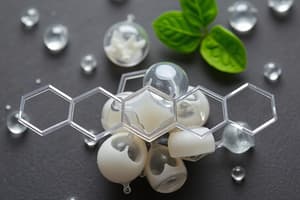Podcast
Questions and Answers
What percentage of the weight of all living matter is made up of six elements?
What percentage of the weight of all living matter is made up of six elements?
- 95%
- 90%
- 99% (correct)
- 80%
What is the general formula for monosaccharides?
What is the general formula for monosaccharides?
- (CH2O)n (correct)
- (CH2O2)n
- (C2H2O)n
- (C2H4O)n
What is the function of starch in plants?
What is the function of starch in plants?
- Transport form of sugar
- Energy storage molecule (correct)
- Protein synthesis
- Structural molecule
What is the characteristic of lipids?
What is the characteristic of lipids?
What is the function of cellulose?
What is the function of cellulose?
Which of the following is NOT a function of proteins in the cell?
Which of the following is NOT a function of proteins in the cell?
What is the characteristic of saturated fatty acid chains?
What is the characteristic of saturated fatty acid chains?
What is the primary component of nucleic acids?
What is the primary component of nucleic acids?
What is the function of steroids in the cell membrane?
What is the function of steroids in the cell membrane?
What is the primary function of antibodies?
What is the primary function of antibodies?
Flashcards are hidden until you start studying
Study Notes
Primary Metabolites
- 92 elements occur naturally on Earth, but only six (CHNOPS: Carbon, Hydrogen, Nitrogen, Oxygen, Phosphorus, and Sulfur) make up 99% of the weight of all living matter.
Carbon
- Carbon is a key element due to its ability to form long chains and rings, making it a crucial component of organic molecules.
Organic Molecules
- Vital metabolites include carbohydrates, lipids, nucleic acids, and proteins.
Carbohydrates
- Carbohydrates are classified into three types: monosaccharides, disaccharides, and polysaccharides.
- Monosaccharides are single sugars, building blocks of energy, and dissolve in water (e.g., glucose, fructose, ribose).
- Disaccharides are two sugars connected together and act as a transport form of sugar in plants.
- Polysaccharides are many sugars connected together and serve as energy storage molecules (e.g., starch) and structural molecules (e.g., cellulose).
Lipids
- Lipids are hydrophobic (insoluble in water) and function as energy storage molecules (fats and oils) and structural molecules (waxes, steroids).
- Fats and oils are energy storage molecules found in seeds, fruits, and provide insulation.
- Saturated fats have no double carbon bonds, while unsaturated fats have one or more double carbon bonds.
- Waxes are found on the surface of leaves and in bee's wax.
- Steroids are composed of four interconnected hydrocarbon rings and function as hormones and stabilize phospholipid tails in cell membranes.
Nucleic Acids
- Nucleic acids are chains of nucleotides and include DNA, RNA, and ATP.
- DNA is Deoxyribonucleic Acid, RNA is Ribonucleic Acid, and ATP is Adenosine triphosphate.
Proteins
- Proteins are chains of amino acids and are vital for the continuation of life on Earth.
- Proteins catalyze most chemical reactions in the cell, provide structural elements, and help bind cells together into tissues.
- They also act as contractile elements, transport vital materials, and protect animals from disease through antibodies and interferon.
- Proteins control gene expression and are incredibly diverse in size, shape, and charge.
- There are 20 known amino acids in nature that make up proteins.
Studying That Suits You
Use AI to generate personalized quizzes and flashcards to suit your learning preferences.




